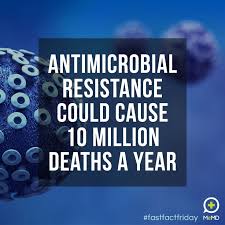16
Nov
Pesticide Use Found to Surpass ‘Planetary Boundaries’ for Resistance
 (Beyond Pesticides, November 16, 2018) Pesticides and biocides used to control bacterial infections in humans and weeds and pests in agriculture are surpassing ‘planetary boundaries’ within which human civilization can continue to rely on these biocides, according to a review by an international team of scientists working on the Living with Resistance project. While the study reinforces the role of susceptible populations in managing resistance, it fails to distinguish essential differences between antibiotic resistance and resistance to pesticides that is identified by Beyond Pesticides.
(Beyond Pesticides, November 16, 2018) Pesticides and biocides used to control bacterial infections in humans and weeds and pests in agriculture are surpassing ‘planetary boundaries’ within which human civilization can continue to rely on these biocides, according to a review by an international team of scientists working on the Living with Resistance project. While the study reinforces the role of susceptible populations in managing resistance, it fails to distinguish essential differences between antibiotic resistance and resistance to pesticides that is identified by Beyond Pesticides.
The study focuses on six different forms of resistance. Researchers looked at antibiotic resistance in gram negative bacteria (such as E. coli, P. aeruginosa, Salmonella) and gram positive bacteria (such as S. aureus, Clostridium) separately, due to their divergent resistance mechanisms. Pesticide resistance was divided among herbicides in general, herbicide resistant crops, insecticides in general, and genetically engineered (GE) crops that produce their own insecticide. Resistance to antibiotics and pesticides are similar in that they are both evolved responses to substances toxic to the organism. However, lumping them together in evaluating their importance to human health and survival does not recognize important differences in context.
“Without new approaches, going to hospital in the future will increasingly become a gamble. More patients will get unlucky, and become infected with untreatable or hard to treat bacteria. This is an urgent risk to human society,” says study coauthor Søgaard Jørgensen, PhD in a press release. The risk of antibiotic resistance is, indeed, a crisis of major proportions. The authors of this study found antibiotic resistance in gram negative bacteria to fall into the category of highest risk –where resistance was found to all relevant antibiotics— while resistance to gram positive bacteria fell in a category in which some antibiotics are generally useful.
For crops genetically engineered (GE) to be herbicide-tolerant or contain plant-incorporated insecticides, the authors found that there is general resistance among pests–though local populations may still be susceptible to the pesticides— while resistance to pesticides not used with such GE crops is not as pervasive.
The authors regard susceptibility to pesticides to be a characteristic that should be conserved, in order to maximize the usefulness of the chemicals. Maintaining susceptibility to antibiotics is a generally-recognized strategy in medicine, where it is addressed (not always successfully) by restricting antibiotic use to situations in which they are required to fight specific infections and by eliminating the use of antibiotics for non-medical uses, such as pest control in plant agriculture or growth promotion in animal agriculture.
With regard to human health and survival, however, there are important differences between antibiotics and pesticides. Antibiotics in medicine are administered to individuals with illness caused by susceptible bacteria. Pesticides are broadcast onto the landscape, also affecting organisms of the target species who are not attacking crops (and therefore provide support for predators and parasites of pests), which increases selection for resistance. Secondly, antibiotics in medicine are reserved for uses in which they are believed necessary, and the risk to the individual receiving the antibiotic can be assessed against the benefits. On the other hand, pesticides are toxic chemicals that negatively affect the health of not only humans, but also other organisms exposed to them.
It is important to recognize the spread of pesticide resistance. It is a symptom of the ineffectiveness of chemical-intensive agriculture, and it leads to increased use of more and more toxic pesticides. For example, widespread and ever-increasing glyphosate resistance led these researchers to classify herbicide-resistant GE crops as regionally ineffective. As a study published this year by UK scientists indicates, the only solution to managing resistance in agriculture is to reduce the need to use these chemicals in the first place.
Organic agriculture seeks to prevent pest problems by creating healthy agroecosystems. The organic approach preserves antibiotics for use in human medicine and eliminates the use of toxic pesticides that endanger human and ecological health and survival.
For more information on resistance, see Beyond Pesticides’ 2011 article on the phenomenon, as well as the program pages for antibacterials, and herbicide tolerant and insecticide incorporated GE crops.
All unattributed positions and opinions in this piece of those of Beyond Pesticides.
Source: Phys.Org, Nature Sustainability










